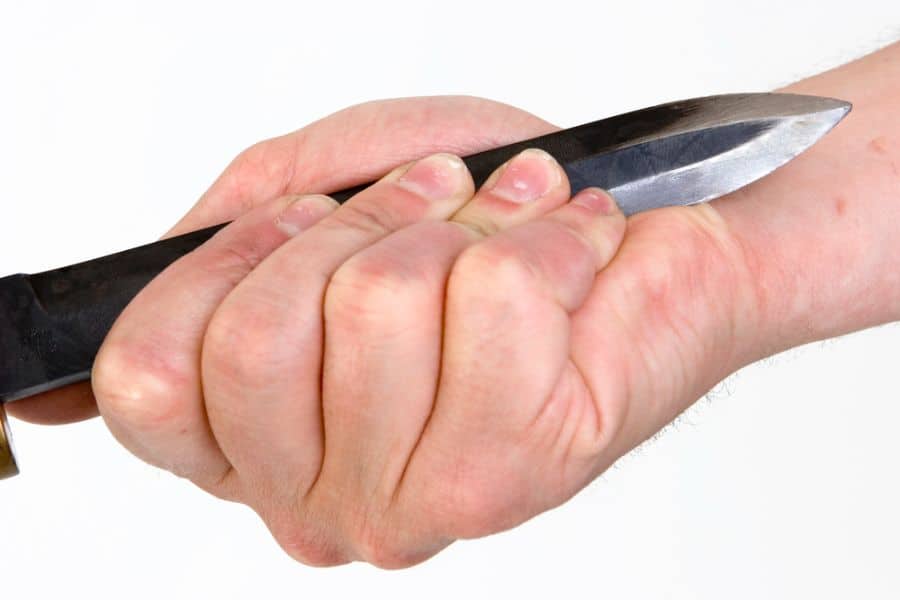There is no reason why a throwing knife needs to have a sharp blade to work properly. One might misconstrue that a knife requires a sharp blade to hit the target, but it can actually hinder your throw instead. The pointiness of the throwing knife has far more to do with how well a knife will stick than its blade sharpness.
Throwing knives should have a pointy tip to stick to a target, but there is no reason why the blade itself needs to be very sharp. A sharp knife is not more likely to stick to the target, is more dangerous to throw, and requires more maintenance than a dull knife.

Now that you know your throwing knife does not need to be sharp to work, you might be wondering why this is the case. In this article, we will cover the reasons why so many experts recommend throwing a dull, pointy knife instead of a sharp one.
Should a Throwing Knife be Sharp? — Why a Dull Knife is Better
A thrower can use a sharp throwing knife with success, but there are a number of reasons why it is not advisable to use a sharp throwing knife.
A sharp throwing knife will increase the danger of the grip and throw, the possibility of ricochets, and the overall blade maintenance and longevity.
Knife throwing comes with the added risk of knives slipping or flying off course unexpectedly, which is more dangerous with a sharper blade, especially if you lose control of the knife.
Sharp blades also decrease the number of ways one can hold and throw a knife, which limits the thrower’s options.
A sharper throwing blade does not penetrate the target any better than a dull blade as long as the knife is pointy. The shape, force, and angle of the knife determine whether the knife will stick to the target.
Additionally, a sharp throwing knife will damage much faster than a dull one. The blade is easier to chip, warp, or bend when it is sharp because it is so thin. Keeping the blade in good condition will be a pain, especially once it has been warped or dented.
“In this video, you will learn how certain techniques may require holding the knife by the blade.”
Why a Sharp Blade is More Dangerous to Throw
There are several different throwing techniques for throwing knives, but they all need the knife to flip through the air as it flies toward the target, creating heightened risks for everyone involved.
Even experienced throwers can make mistakes; a sharp throwing blade gone astray can be incredibly dangerous to the thrower and their surroundings.
Some throwing techniques like the blade grip, present an even greater risk of injury when throwing. A blade grip is when the thrower holds the knife by the blade rather than the handle, which is done to adjust the amount of rotation in the throw. Unfortunately, this cannot be done with a sharp blade because it would cut the thrower’s hand.

Why a Sharp Blade Isn’t More Likely to Hit the Target
Some might think that a sharper blade will cut through the target better than a dull knife, but this frankly does not make it any easier for the blade to cut through the material. Regarding physical shape, the knife only needs to have a pointed end to stick to the target.
Throwing knives does not need to have sharp blades because most of the blade will not penetrate the material when it hits the target. Instead, the knife needs the pointed end to wedge enough of the tip into the target to keep the knife in place.
This means it does not matter whether or not the blade is sharp because it has nothing to do with whether or not the knife will penetrate.
When it comes to sticking to the target, the rest is up to the quality of the throw. You must aim the knife straight and hit the target with the pointed edge.
The knife should be held tight but relaxed and thrown with a stiffened wrist to hit the target at the right angle. The throw needs to be forceful enough to drive the point into the target.
Why a Sharp Throwing Knife Requires More Upkeep
Maintaining your knife sharpness means the blade needs to grind against a hard, coarse material. This means that the sharper the blade is, the thinner it is, and the more sharpening it needs, the thinner it gets. The thinner the blade is, the easier it is to damage, especially when throwing it against another hard object, as when throwing knives.
A blade doesn’t just get dull but can chip, warp, or even bend when used with great force, as it often happens when throwing a knife. Minor damages can buff away when sharpened, but larger dents and chips may be challenging to restore.
Not to mention that the thinner a blade gets from frequent sharpening, the sooner it will completely break.
Knife throwers recommend using a durable, blunt throwing knife because knife throwing is such a high-impact activity that will result in damage to the knife. This means your knife will be easier to maintain and last longer than a sharp knife, making the knife-throwing experience far more enjoyable.
In Conclusion, Should a Knife Be Sharp?
When it comes to knife throwing, choosing a blade can be tricky. There are many different options! You may have come here wondering which kind of throwing knife would be the best for you.
Although sharp blades can and have been successfully used, even experts prefer to throw dull throwing knives because of their advantages.
A good throwing knife should still have a sharp, pointed tip. Having a dull blade allows the thrower that much more safety, control, and longevity of the knife, making it a great choice. Now that you know which type of blade is best, you can begin practicing for the perfect throw!
References:

